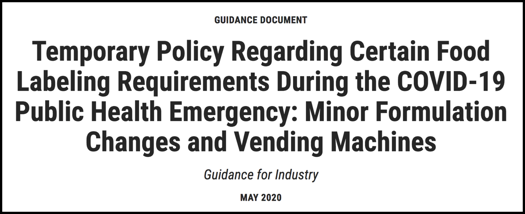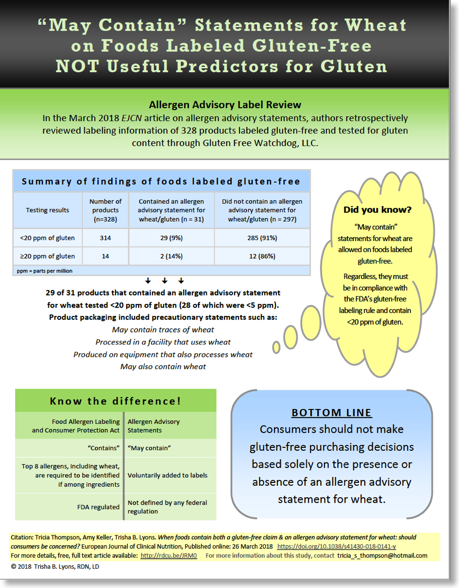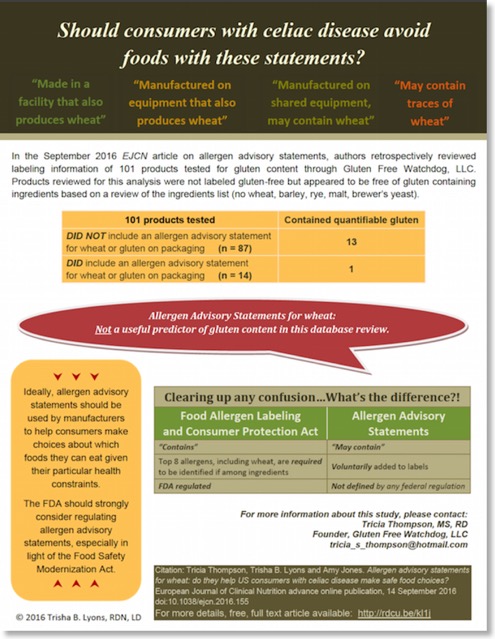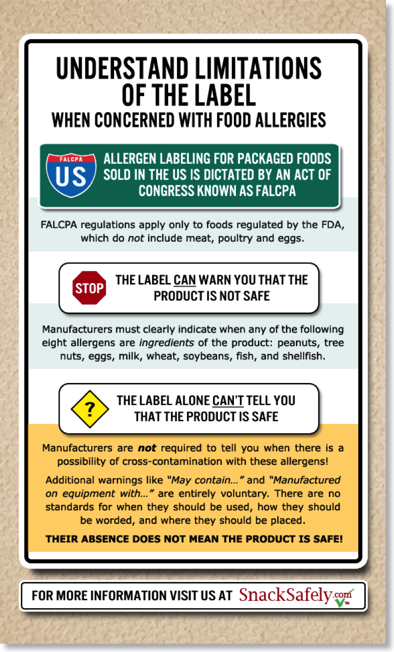FDA Temporary Labeling Requirements During COVID-19
On the evening of Friday, May 22nd 2020, the FDA issued new guidance relaxing the requirements around the labeling of ingredients due to the supply issues caused by the COVID-19 pandemic. As one might expect, this rocked the world of those with food allergies as well as those with gluten-related disorders. “FDA is issuing this guidance to food manufacturers to provide temporary and limited flexibilities in food labeling requirements under certain circumstances. Our goal is to provide regulatory flexibility, where fitting, to help minimize the impact of supply chain disruptions associated with the current COVID-19 pandemic on product availability. For example, we are providing flexibility for manufacturers to use existing labels, without making otherwise required changes, when making minor formula adjustments due to unforeseen shortages or supply chain disruptions brought about by the COVID-19 pandemic.” In response to the COVID-19 pandemic, the FDA is allowing manufacturers to make minor changes in packaged food ingredients without updating ingredient lists to reflect these changes. The guidance states that this should only be done when the ingredient being substituted does “not cause any adverse health effect”, with “gluten” being specifically noted as an example of an ingredient that should not be substituted in. In other words, this FDA guidance theoretically means that a product which was previously gluten-free would remain gluten-free, even if some ingredient(s) are modified. But the possibility does exist that companies could inadvertently substitute in a gluten-containing ingredient that would not be noted in the ingredient list. “Ms. Vargas served on the expert panel to develop Voluntary Recommendations for Managing Celiac Disease in Schools, Child Care and Education Programs, a joint effort of Children’s National Medical Center, the Celiac Disease Foundation, and RESOLVE.” If you haven’t yet read this guidance, it states in a nutshell that during this period of food shortages and supply disruptions, FDA is allowing manufacturers to make certain ingredient substitutions without changing the ingredients list.Allowed substitutions include those for minor ingredients (generally comprising 2% or less by weight of the product). FDA states that these changes should* be consistent with safety factors meaning that “the ingredient being substituted for the labeled ingredient does not cause any adverse health effect (including food allergens, gluten, sulfites, or other ingredients known to cause sensitivities in some people, for example, glutamates).” Allowed substitutions also include “different varieties of the same ingredient.”* The use of “should” in an FDA guidance document means that something is suggested or recommended, but not required.
Here are a few resources to help us learn more about this change.
Read More: https://bit.ly/3fziFy2
Download Guidance PDF: https://bit.ly/2Nemkoz
Laura Allred, Ph.D. - GFCO Regulatory Manager and Lola O’Rourke, MS, RDN - GIG Education Coordinator discuss the impact of this ruling.
Watch the Webinar: https://bit.ly/2YJeDfo
Notes:
Mary Vargas, partner, discusses some of the legal details of the FDA’s guidance.
Watch the Video: https://bit.ly/3d5bQT1
Notes:
Gluten-Free Watchdog gives us their analysis of this policy and some suggestions for managing it.
Gluten-Free Watchdog's Entire Article: https://bit.ly/2UOdQsm
Notes:
Urgent Call to Action: Comment today on FDA's temporary policy allowing manufacturers to make certain ingredient substitutions without changing the ingredients list - June 2020
It's essential to have our voices heard about this policy. Future labeling practices maybe be defined by this [as of now] temporary policy. You can add your comment to Docket number FDA-2020-D-1139-0009.
Gluten-Free Watchdog suggests we can use any or all of the submitted letter. Or you can state that you are in support of the letter sent by Gluten-Free Watchdog. Here is a PDF of the letter submitted to the FDA: https://bit.ly/2Ndn2m7
Click here to let the FDA know how you feel: https://bit.ly/2NeXzsE
Gluten-Free Watchdog's Entire Article: https://bit.ly/2YzfgIw
SnackSafely.com is assembling a list of companies that have pledged to label all ingredients despite the changes. Excellent!
Special thanks to my friend Sarah @ Celiac in the City for sharing this list!
List of Manufacturers: https://bit.ly/2N69bha
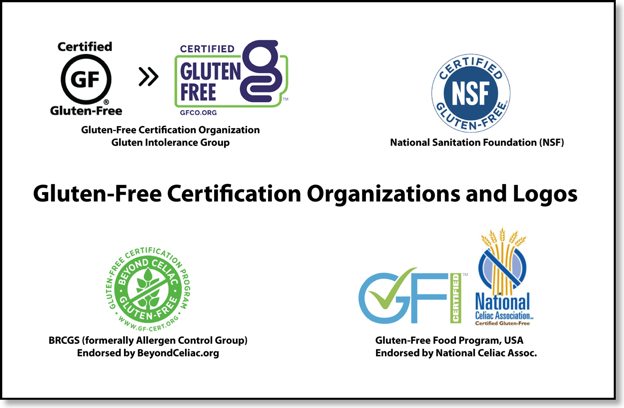
To be compliant, manufacturers must follow a few general guidelines when determining whether an undeclared ingredient substitution is allowed: The change can’t compromise the safety of the product (eg, introduction of major allergens or other sensitive ingredients). The omitted ingredient can’t be a major ingredient (eg, replacing wheat flour with rice flour in a muffin) or a characterizing ingredient (eg, replacing butter with margarine in a product with a “made with real butter” claim). The change can’t impact nutrient content or health claims made on the label. The change can’t have a significant impact on the nutritional quality of the finished product. Substitutions of Different Varieties of the Same IngredientDifferent varieties of the same ingredient, such as fruits or vegetables, may be freely substituted without label changes. For example, a product listing “jalapeño peppers” in the ingredients list may substitute another variety of pepper, regardless of whether it’s a major or minor ingredient.Manufacturers also may temporarily substitute fats and oils without label changes if they’re from the same category of fat (animal/vegetable/marine animal) and have a similar fatty acid profile.Similarly, due to a low supply of bleaching agent, products declaring “bleached flour” as an ingredient may substitute unbleached flour without declaring it in ingredients lists.
Read entire article: https://bit.ly/386Hteg
Updates:
06/26/20 - Added Today’s Dietitian link.
Gluten-Free Label Reading
On the evening of Friday, May 22nd 2020, the FDA issued new guidance relaxing the requirements around the labeling of ingredients due to the supply issues caused by the COVID-19 pandemic. As one might expect, this rocked the world of those with food allergies as well as those with gluten-related disorders.
To learn more about this labeling change, check out our article: https://bit.ly/GIGECW-FDA-Temp-Labeling
OK, true confession time. Before 2003 I rarely looked at a product's ingredient label. I saw no point in it; if it tasted good - I ate it. Hmmm, could this have been a contributing factor in my steadily increasing weight and my rapidly declining health? Yeah.

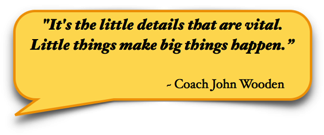
It should be no surprise that attention to detail increases our chances of success in the gluten-free lifestyle. After all, something measured in parts per million rearranges our lives. Talk about little things making big things happen. Coach Wooden’s words take on a whole new meaning for those with a gluten-related disorder.
Knowing what's in our food is probably one of the most important details. President Theodore Roosevelt signed into law the Pure Food and Drugs Act of 1906. Known as the Wiley Act, it gave the federal government the power deem a food “misbranded” if ingredients were “false or misleading,” or deemed “adulterated” if it contained ingredients harmful to health. Sadly, it would take nearly a century before the presence of food allergens would be recognized. A decade later, gluten-free regulations finally make it on the books.
The Protection Agencies
Only a few different governmental agencies regulate food safety. In this article, we’ll be discussing the US Food and Drug Administration (FDA) and the US Dept. of Agriculture (USDA). The US Treasury’s Alcohol and Tobacco Tax and Trade Bureau (TTB) regulates beverage alcohol [as in gluten-free beer]. Sorry beer lovers, we won’t be getting into those regulations in this article.
FDA vs. USDA
The FDA regulates most packaged foods we see on the store shelves. The USDA regulates meat, poultry and egg products, and mixed food products that contain more than three percent raw meat or two percent or more cooked meat or poultry (e.g., soups, chilis, frozen entrees).
While USDA regulated products are encouraged to follow FDA regulations, it is not required. [This is valuable information to know when it comes to reading ingredient lists. More on this later.]
Estimates show that 80% to 90% of USDA products voluntarily comply. If you see a “Contains” statement or other indication of a USDA product, major food allergen will be plainly listed.
FDA & the Top 8 Food Allergens
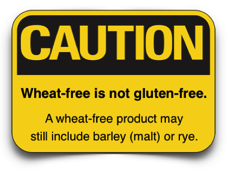
The FDA’s Food Allergen Labeling and Consumer Protection Act of 2004 (FALCPA) requires food labels to clearly identify the food source names of all major food allergens used to make the food. They must use the common or usual name of an ingredient [e.g., Modified Food Starch (wheat)} or use a “Contains” statement next to the ingredient list. [e.g., Contains Wheat, and Milk]
What are the major allergens as defined by the FDA?
- Milk
- Eggs
- Fish (bass, flounder, cod)
- Crustacean shellfish (crab, lobster, shrimp)
- Tree nuts (almonds, walnuts, pecans)
- Peanuts
- Wheat (including all types: durum, spelt, emmer, farina, farro, einkorn)
- Soybeans
Source FDA: http://bit.ly/FDA-Big8
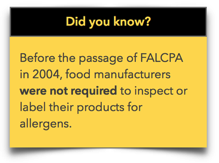
You’ll notice the Top 8 list above only includes wheat. It does not include gluten-containing ingredients barley (malt), rye, or oats*. Fortunately, barley is most commonly listed as “barley," "barley malt," or simply “malt”. Rye is rarely used in a form other than flour and would appear in the ingredient list.
*Oats (and products that contain them) that are not explicitly certified or labeled gluten-free are off-limits to anyone following a gluten-free diet. They are a high-risk ingredient because they are exposed to substantial amounts of gluten via cross-contact from field to packagings. Oats require additional knowledge and careful consideration.
 "What Oats Through Yonder Package Breaks?"
http://bit.ly/GIGECW-PureOats
"What Oats Through Yonder Package Breaks?"
http://bit.ly/GIGECW-PureOats
The Ingredient Label
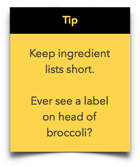
The ingredient label is your frontline defense in determining the gluten-free status of a product. An important fact to know: FALCPA labeling regulations do not apply to the potential or inadvertent presence of food allergens resulting from cross contact. Cross-contamination of a food or ingredient can occur at harvest, transport, manufacturing, or packaging. Calling the manufacturer may be required not only for ingredient clarification but also to determine manufacturing practices.
Cross-contact and Good Manufacturing Practices
Manufacturers are encouraged [not required] to follow Current Good Manufacturing Practices (CGMP). Part of CGMP means developing and executing food allergen control plans. The plan must address six elements: training of processing and supervisory personnel, segregation of food allergens during storage and handling, validated cleaning procedures for food contact equipment, prevention of cross-contact during processing, product label review and label usage and control, and a supplier control program for ingredients and labels.
Voluntary Allergen Advisory Statements
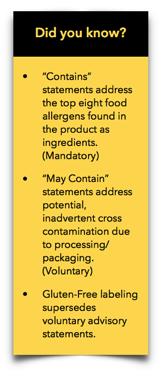
Gluten-free experts and third-party testing tell us Food Allergen Advisory statements are not useful in determining the gluten-free status of a product.
You may find a product labeled “Gluten-Free and/or Wheat-Free” or even bears a GFCO gluten-free certification logo that has a Food Allergen Advisory statement that includes wheat. Yes, this product complies with current FALCPA labeling laws.
For products not certified gluten-free, call the manufacturer to ask questions. Ask about the facilities, the production lines, and their policies, procedures for allergen handling, and testing protocols. If they do not answer the questions to your satisfaction, find another manufacturer with a similar product that does meet your needs.
 "May Contain Statements"
http://bit.ly/GIGECW-MayContain
"May Contain Statements"
http://bit.ly/GIGECW-MayContain
The Definition of Gluten-Free
As we discussed above, FALCPA does not directly address gluten. Before the FDA could create regulations regarding “gluten-free,” they needed to define what “gluten-free” means. It took ten years for the definition to finalize, but the voluntary gluten-free labeling regulation went into effect August 5th, 2014.
The FDA’s definition of “gluten-free,” “no gluten,” “free of gluten,” or “without gluten” is as follows:
“…the food either is inherently gluten free; or does not contain an ingredient that is: 1) a gluten-containing grain (e.g., spelt wheat); 2) derived from a gluten-containing grain that has not been processed to remove gluten (e.g., wheat flour); or 3) derived from a gluten-containing grain that has been processed to remove gluten (e.g., wheat starch), if the use of that ingredient results in the presence of 20 parts per million (ppm) or more gluten in the food. Also, any unavoidable presence of gluten in the food must be less than 20 ppm.”Source: http://bit.ly/FDA-QA-GF-Labeling
Notice the last sentence of the definition: "Also, any unavoidable presence of gluten in the food must be less than 20 ppm.” This means cross-contact.
I hear you…
“Whoa, this is confusing and complicated. Isn't there an App?"
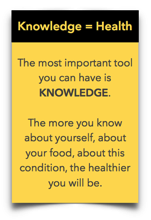
Websites, published lists, and apps that report a product's gluten-free status are excellent tools to help narrow down product selection. Please do not use them as the sole means to determine the gluten-free status.
Companies change product ingredients at will, generally without notice. The product label will reflect any ingredient changes. Most companies will refer you to the ingredient list found on the product for the most up to date information. A published list (on paper or electronic form) is only as accurate as its most recent update.
Reading the label. Finally!
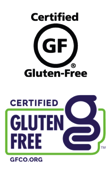
- Look for a third-party gluten-free certification mark - like GFCO's.
- Gluten-Free Certification Organization requires all finished products and individual ingredients using the GFCO logo contain 10 parts per million or less of gluten.
- Know your certification organizations (see logos below). When companies mark their products as GF it may appear as if they are actually certified. It might simply be a logo from their marketing or package design department.
- Read the ingredient list. Yes, even certified products. If you see any of following ingredients, the product is not gluten-free.
- Wheat (including durum, spelt, emmer, farina, farro, einkorn)
- Rye
- Barley
- Oats (unless certified gluten-free)
- Brewer's Yeast
- Malt
- Ingredients needing verification:
- Yeast Extract - this could be a by-product of the beer brewing process. Verify with manufacturer in non-GF labeled products.
- Vinegar - FDA defines the single word "vinegar" to mean apple cider vinegar. However through the certification process, GFCO has encountered some usages of malt vinegar labeled as "vinegar". Remember barley/malt is not required to be disclosed. Not a large area of concern, but if you are unfamiliar with a manufacturer or product, it might be a good idea to inquire about the source of their vinegar. Better safe than sorry.
- USDA Products - Products are not required to comply with FDA's FALCPA regulations. If you see a "Contains" statement (or some other wording) that a package is complying with FALCPA, you know wheat must be declared. If you do not see a "Contains" statement, you'll need to verify the source of these ingredients (they could come from wheat):
- Starch
- Food Starch
- Modified Food Starch
- Dextrin

Congratulations!
You’ve made it! I hope I’ve increased your knowledge on this multi-layered subject.
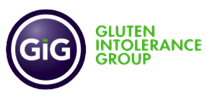
Label Reading Resources
Gluten-Free Labels 101 Video Webinar
http://bit.ly/GIG-GFLabels101
Q&A Gluten-Free Labels 101 PDF
http://bit.ly/GIG-QA-GFLabels101
Gluten-Free Label Reading
http://bit.ly/GIG-LabelReading
3 Tips for Gluten-Free Label Reading
http://bit.ly/GIG-3TipsGFLabels
Getting Started on a Gluten-Free Diet
http://bit.ly/GIG-GettingStarted
Gluten-Free Certification Organizations and their Logos


Practical Gastroenterology - December 2019
Timely Topics in Gluten-Free Labeling
NUTRITION ISSUES IN GASTROENTEROLOGY, SERIES #193
By: Amy Keller MS, RDN. LD.
Excellent article from Amy Keller, MS, RDN. LD
“Patients with the inherited autoimmune condition, celiac disease, must avoid gluten in any form to help heal damaged intestinal villi. The Food and Drug Administration’s (FDA) Gluten Free (GF) label is intended to help instill trust in consumers with celiac disease and gluten-related disorders. Studies show that the vast majority of labeled GF foods meet the FDA’s standard of <20 ppm gluten, but consumers remain leery of some labeled GF products, especially those displaying allergen advisory statements for wheat. Products containing malt, malt extract, and other gluten-containing ingredients continue to show up on store shelves, which may indicate that FDA enforcement of the GF labeling rule is lacking. Consumers may find a personal allergen detection tool to be an attractive option to assist in testing food for gluten content, but these also come with significant limitations.”
Read More: https://at.virginia.edu/33RLEqy
In the confusing landscape of food labels, assumptions are risky but knowledge is power.Whether you’re new to the food allergy world or a veteran, there is never a time you can let your guard down. Read More: http://bit.ly/2H3oPW8
Required Reading With Food Allergies or Celiac Disease
By: Gina Clowes
Published: April 1, 2015
Certified master life coach, Gina Clowes offers up some great labeling reading advice.
As many of us who shop for groceries know, gluten can appear in many shapes and forms on a product label. Lots of brands do label their products gluten-free and some even go the extra mile to get a gluten-free certification — but there are still thousands that don’t. So, what does that mean if you have gluten sensitivity or have been diagnosed with celiac disease? Read More: https://bit.ly/3EyMUTo “Let’s face it, the gluten-free diet is complex and difficult to maneuver. Add to this the issue of common ingredients that never seem to get off lengthy lists of “things to question” and it’s no wonder that so many people doing their best to avoid gluten are still assailed by confusion and anxiety. That’s why we think it sometimes makes more sense to explain why you don’t have to worry about certain ingredients. Here are the leading ingredients that you can stop worrying about.” “The information in our ingredients index will help you read a food label. It is based on the research we have done by interviewing experts in the field of food science.”
Gluten-Free Label Reading: From Novice to Expert
Published: March 1, 2022
If you find yourself in the packaged food aisles reading labels, you'll run into some strange and confusing ingredients. You'll need to know what they are and if they are gluten-free. Keep in mind, if the ingredient is gluten-free, it does not mean that it's healthy for you. Choose wisely!
“Top 10 Ingredients you really don't need to worry about”
http://bit.ly/2Dn9z7m
“Ingredient Index”
http://bit.ly/2Te1JTm
Updates:
4/21/22 - Add Gluten-Free Living’s link
04/12/21 - Add updated GFCO logo and GF certification organizations and their logos
06/20/20 - Added link to FDA’s Temporary Labeling Guidance.
12/5/19 - Added Practical Gastro Article from Amy Keller MS, RDN. LD.
11/14/18 - Added Confusing Ingredients
04/15/18 - Added AllergicLiving.com article from Gina Clowes
May Contain Statements Updated
May Contain, Manufactured in a facility, etc
Voluntary Food Allergen Advisory Statements
Updated March 30th 2018
I've added the Allergen Advisory Statements Study that was published in Sept. 2016.
Alan Klapperch
Branch Manager "Gluten-Free Label Reading"
http://bit.ly/GIGECW-GF-Label-Reading
"Gluten-Free Label Reading"
http://bit.ly/GIGECW-GF-Label-Reading
You may find a product labeled “Gluten-Free and Wheat-Free” that bears a GFCO gluten-free certification logo, but, it also has a “May contain traces of” statement that includes wheat. WHOA!
Believe it or not, this product is in compliance with current FDA Food Allergen Labeling and consumer Protection Act of 2004 (FALCPA) labeling laws. 
“Contains” statements address the top eight food allergens found in the product as ingredients. (Mandatory)
“May Contain” statements address potential, inadvertent cross contamination due to processing/packaging. (Voluntary)
Gluten-Free labeling supersedes voluntary advisory statements.
For years, the gluten-free community has been warned about using advisory statements for determining the gluten-free status. Their usefulness is diminished due to the lack of definition and regulation.
We covered this information in our March 19th 2011 newsletter and meeting, but it bears repeating. In 2010, HealthNow hosted their 2nd Annual Gluten Sensitivity & Celiac Forum. Cynthia Kupper, RD, GIG Executive Director was a featured speaker. She was asked this question during her Q&A session:
Q: The ingredient list contains no gluten, but there's a statement about “Processed in the same facility as...”or “Processed on the same equipment as...” what do you do? A: That’s a voluntary advisory statement designed for people with IgE allergies. Many companies use it as a “CYA”. No meaning for celiacs. A group of RD's determined that it would reckless of them to suggest that statement should be used to determine gluten-free status. If you have an IgE (anaphylactic reaction), you need to think about it.A "Contains..." statement is an allergen statement and required by law. "May Contain" is not an allergen statement.”
Source: 2010 HealthNow Gluten Sensitivity & Celiac Forum DVD
Check out this example of Aldi's Baker's Corner Instant Pudding. After the ingredient list, you'll see a statement that reads: "MANUFACTURED IN A FACILITY THAT USES TREE NUTS, SOY, MILK, AND WHEAT."
Update: While it may still be gluten-free, this product is no longer labeled gluten-free.
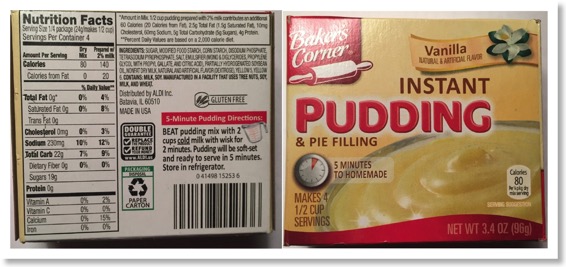
I reached out to Aldi's to ask about this product. On May 15th, 2015, the Quality Control Supervisor from Subco Foods in Sheboygan, WI (the company that does the pudding) called me. I asked about the production lines for this product - did they run any gluten products on this line?
Tamela’s answer was very thorough! The pudding lines are dedicated - only pudding is done on them - nothing else - no gluten. They test raw materials for gluten coming into the plant - they test during production and they also send samples out to a private lab for finished product testing. Between pudding flavor runs (vanilla/chocolate/etc), they follow a strict teardown and cleaning process. They are very serious about food allergens.
Also the pudding lines are isolated from their jello lines. She said they do not want dairy getting into the jello lines.
So, what do we do with products like this? Call the manufacturer to ask questions. Ask about the facilities, the production lines, and their policies and procedures for allergen handling. If they do not answer the questions to your satisfaction, find another manufacturer with a similar product that does meet your needs.
Read more:
Building upon their 2016 paper [see below], Tricia Thompson, Amy Keller, and Trisha B. Lyons published "When foods contain both a gluten-free claim and an allergen advisory statement for wheat: should consumers be concerned?" on March 26, 2018 in the European Journal of Clinical Nutrition.
This retrospective database analysis included a total of 328 gluten-free labeled products previously tested for gluten content by Gluten-Free Watchdog.
Here's what they found…
SUMMARY
On the basis of this retrospective data analysis, the use of allergen advisory statements (regardless of type) on foods labeled gluten-free was not indicative that a food was out of compliance with the gluten-free label ing rule. Due to the current lack of federal regulations for allergen advisory statements, consumers with celiac disease and other gluten-related disorders should not make gluten-free purchasing decisions based solely on the presence or absence of an allergen advisory statement for wheat.One issue that may be causing mistrust among gluten-free consumers when products contain both a gluten-free claim and a precautionary statement for wheat is the lack of required testing for foods labeled gluten-free. In the US,while foods must contain <20 p.p.m. of gluten to be labeled gluten-free, testing is not included in the FDA’s codified rule.
Increased education is needed to advise consumers that a gluten-free claim applies to gluten that may be in a product due to ingredients and cross-contact. Under the gluten-free labeling rule, a gluten-free claim on product packaging means the food must comply with all criteria of the rule,including containing <20 p.p.m. of gluten. This is true regardless of the presence or absence of an allergen advisory statement for wheat [2].
When combining the results of both studies…4/45 (9%) products that DID include an allergen advisory statement for wheat or gluten on product packaging contained quantifiable gluten.
52/384 (14%) products that did NOT include an allergen advisory statement for wheat or gluten on product packaging contained quantifiable gluten.
The FDA should strongly consider regulating allergen advisory statements, especially in light of the Food Safety Modernization Act.
– Because advisory labels are voluntary, there is no guarantee products without these warnings will not contain traces of allergens. If you are ever unsure about a packaged food, Allergic Living suggests calling the manufacturer to find out about its food allergy management practices. If company representatives can’t adequately answer your questions, avoid the food.”
Tricia Thompson, Trisha B. Lyons, and Amy Jones analyzed allergen advisory statements of 101 products previously tested for gluten content by Gluten-Free Watchdog. These products were not labeled gluten-free, however the ingredient list did not include any gluten containing ingredients (no wheat, barley, rye, malt, or brewers yeast).
On September 14th 2016, they published Allergen Advisory Statements for Wheat: NOT a Useful Predictor of Gluten Content.
Here's what they found…In this database review, precautionary labeling for wheat or gluten on products not labeled gluten-free but appearing to be free of gluten-containing ingredients was NOT a useful predictor of gluten content. In some cases, consumer reliance on precautionary statements for wheat or gluten could have resulted in choosing a product contaminated with gluten.
• 87/101 (86%) products tested for gluten did NOT include an allergen advisory statement for wheat or gluten on product packaging.
• Fourteen products (14%) tested for gluten DID include an allergen advisory statement for wheat or gluten on product packaging.
• Of the 87 products that did NOT include an advisory statement, 13 (15%) contained quantifiable gluten at or above 5 ppm including 4 products (5%) that tested at or above 20 ppm of gluten.
• Of the 14 products that DID include an advisory statement, only 1 (7%) contained quantifiable gluten at or above 5 ppm.
SUMMARY
On the basis of this analysis, the current use of allergen advisory statements for wheat or gluten are not useful predictors of whether or not a single or multi-ingredient food product contains 20 or more p.p.m. of gluten. Precautionary statements should be regulated and standardized so that they are helpful to the consumer.In terms of foods labeled gluten-free, consumers are advised to trust the label regardless of allergen advisory statements for wheat or gluten. This is due to the gluten-free labeling rule applying to both gluten in ingredients and gluten that may be found in a product due to cross contact. However, when it comes to foods not labeled gluten-free but appearing to be "gluten-free" based on ingredients, there are no established guidelines for individuals with celiac disease on whether they should avoid products with allergen advisory statements for wheat or gluten.
Increased education is also required to let consumers know that FALCPA includes ingredients only and does not include allergens that may be in a product unintentionally due to cross contact. Increased education is also needed to let consumers know that a gluten-free label applies to gluten that may be in a product due to ingredients and cross contact and that regardless of the source of gluten the product must contain less than 20 p.p.m. gluten.![]()
To learn more about this confusing matter, please watch these excellent Q&A videos from Gluten-Free Watchdog.
“‘May Contains’ on Food Labels: What You Need to Know"
By: Claire Gagné
http://bit.ly/27fg1ok
“Advisory labels or “may contains” (also called precautionary warnings) alert customers that traces of an allergenic food might unintentionally have wound up in a packaged food.
This inadvertent cross-contact can occur because of shared processing lines or baking equipment, or because workers use the same gloves while producing a number of products.
– The wording of the warning label does not give an indication as to the risk of the allergen being present.
Updates:
3/30/18 - Updated to include "When foods contain both a gluten-free claim and an allergen advisory statement for wheat…" paper
10/20/16 - Updated to include "Allergen advisory statements for wheat: do they help US consumers with celiac disease make safe food choices?"
